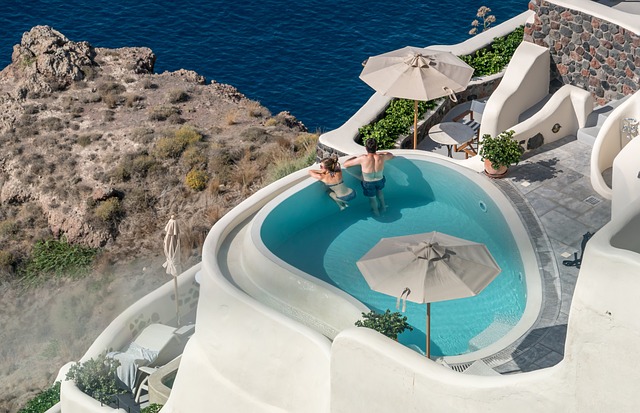A swimming pool is not the most eco-friendly system. Pools consume a lot of chemicals, electricity and water which is not good for our environment. The manufacture of chemicals, production of electricity and capture of water places a significant load on our environmental sustainability.
However, there are many ways to make your pool more eco-friendly by reducing chemical, energy and water usage.
Table of Contents
1. Install a Pool Cover
Pools contain a large amount of water.
The average backyard in-ground swimming pool holds about 40,000 liters (15,000 gallons) of water and you need to drain and refill your pool every 7 to 10 years to eliminate the total dissolved solids in the water.
However, it’s not the emptying and refilling that uses most of the water. It’s the topping up the pool every few weeks to replace the water lost to evaporation.
Evaporation is not a bad thing! The water evaporates into the atmosphere, forms into clouds and precipitates back to the ground again. It’s a normal part of the global water cycle.
But when every pool owner has to add 1000 litres of water to their pool every month, it really adds up! We need more dams and water treatment plants. This is bad for our environment and your wallet.
One simple solution to make your pool more eco-friendly is to install a pool cover. A cover will prevent over 90% of the water evaporation from your pool saving our water resources and your wallet.
2. Install a Cartridge Filter
A cartridge filters system passes water through a cylindrical fan-folded filter element to trap contaminants and dirt. The cartridge is easy to remove from the filter tank and easy to clean with a garden hose when required.
Cartridge filters are more water efficient than a sand filter because they do not require backwashing like a sand filter. This saves a lot of pool water.
Regular backwashing takes water from the pool and washes it backwards through the sand filter into the drain. This is the only way to clean a sand filter. However, every time you backwash the sand filter you lose some pool water and your chemicals to the drain. You must refill the pool and add more chemicals to rebalance the pool chemistry.
3. Install LED Pool Lighting
Modern LED pool lights consume up to 80% less power than conventional incandescent lights. Replace a 200 watt light bulb with a 30 watt LED bulb for the same output of light to make your pool more eco-friendly and save on your power bills.
LED lights have many benefits over conventional pool lighting. They are more durable and long lasting. LED lights have 10 times the lifespan of incandescent lights and last twice as long as fluorescent lights. LED pool lights are available in a range of party colors and some models can change color automatically or be controlled from a remote control.
4. Convert to Saltwater Chlorination
All swimming pools need to be constantly sanitized with chlorine or some other chemical system to prevent algae and bacteria living in the water.
Salt water swimming pools and spas are the most popular option for many pool operators to make your pool more eco-friendly. They require less maintenance, demand less chemicals and are inexpensive to operate.
Salt water pools are constantly sanitized with a minimal level of chlorine generated from a salt water chlorinator unit. There is no requirement to add chlorine or any other sanitizer to the pool.
Conversion to salt water requires the installation of a chlorinator cell and purchase of pool salt. However, that cost is easily recovered by the lower operating costs and reduced maintenance requirement.
5. Run the Pump in Off-Peak Periods
Off peak power periods are usually 8pm to 6am and 9am to 4pm.
Run the pool pump during these times to take the demand off peak power and to make your pool more eco-friendly. The number of power stations are built to handle peak load. If the peak load can be reduced we don’t need so many power stations.
Most electricity suppliers can install a separate circuit and meter for the pool pump. Then they charge you at cheaper off-peak electricity rates.
6. Install a Variable Speed Pump
Traditional single speed pool pumps are out-of-date and inefficient with energy consumption. The pump runs at one speed (usually fast) for all applications of pumping and filtering.
Variable speed pumps are the new technology. They cost significantly less to operate as the pumps run at lower revolutions per minute (RPM) giving more filtering capacity while consuming less power.
These new variable pumps have with ultra-efficient brush-less magnet motors, as used in hybrid electric cars. This also makes the pump very quiet.
Conclusion
It doesn’t take much effort to reduce your pool running costs. Go green with your swimming pool to reduce chemical, electricity and water usage. If every pool owner implements one or more of the above ways to make your pool more eco-friendly our world will be a better place.


